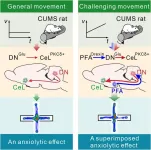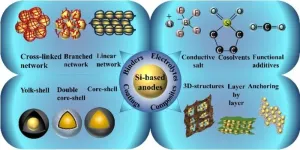(Press-News.org) New Haven, Conn. — Treatment with a molecule known as A485 can quickly and temporarily increase levels of white blood cells, a critical part of the body’s immune system, an effect that is difficult to deliver with currently available pharmaceuticals, a new Yale study finds.
In an experiment, the researchers found that exposure to the molecule in mice caused white blood cells to mobilize from the bone marrow, a response that could inform future treatment for patients who need a boost in immune activity, the researchers say.
The findings were reported Jan. 31 in the journal Immunity.
There are certain conditions in which individuals may be affected by low white blood cell counts. These include genetic conditions — such as severe congenital neutropenia, a rare disease in children who are prone to repeated infections due to low levels of white blood cells called neutrophils — and acquired conditions, such as reduced white blood cell counts following chemotherapy treatment. Then there are diseases like leukemia where white blood cell levels are too high.
However, there are few pharmacological options for adjusting white blood cells counts in patients with abnormal levels.
For the new study, researchers observed the effect A485 had on blood cells in mice. The molecule, which the researchers have proposed calling “prohiberin,” inhibits proteins that modulate gene expression, essentially turning genes on or off.
“We found that this molecule, A485, provoked a strong increase in white blood cells, including those involved in both the adaptive and innate immune systems,” said Nikolai Jaschke, lead author of the study and a postdoctoral fellow in the lab of Andrew Wang, associate professor of internal medicine (rheumatology) and of immunobiology at Yale School of Medicine.
This increase in white blood cells, deployed from the animals’ bone marrow, occurred shortly after exposure to A485. About 12 hours later, the researchers said, cell counts dropped back to previous levels. This short-term effect is key, said Jaschke.
“Currently, the main treatment for low white blood cell counts is G-CSF, or granulocyte colony-stimulating factor, which is produced by the body and can be administered as a drug,” said Jaschke. “But it has a long-lasting effect, which can be harmful in some circumstances, limiting its wider clinical use. A485 is just as potent as G-CSF but less enduring.”
To see if this brief increase in white blood cells might be effective in treating infection, the researchers gave A485 to mice that had received chemotherapy — and, therefore, had damaged bone marrow — and had also been infected by the bacteria listeria.
Even with damaged bone marrow, mice that received A485 survived at higher rates than those that did not, as they were able to clear the bacteria more effectively. This finding is especially important in the context of cancer treatment, said the researchers.
“When patients develop low white blood cell counts after chemotherapy, a condition called neutropenic fever, antibiotics are the only approved therapy,” said Jaschke. “A485 could be another option.”
Going forward, Jaschke noted, studies should test A485 against other infections, as listeria is not the most common pathogen patients tend to encounter when immunocompromised. Additionally, more research needs to be done to better understand how A485 has the effect that it does. But the current study offers some clues.
Jaschke and his colleagues found that A485 works, in part, through endogenous G-CSF, which is a protein that stimulates the bone marrow to make more blood cells. They also found that combining G-CSF and A485 produced an additive effect on white blood cell mobilization that could be beneficial as a treatment.
Further, the study revealed that A485 activates what’s known as the body’s “stress axis,” engaging a hormone that, until now, was believed to only regulate levels of another hormone, cortisol.
“But we found that this hormone can regulate neutrophils, which opens up a whole new field of questions,” said Jaschke. “Along with A485 working through G-CSF, these findings mean there are pathways that mediate bone marrow mobilization that we don’t even know about yet.”
END
Molecule can quickly, and briefly, boost white blood cell counts
2024-01-31
ELSE PRESS RELEASES FROM THIS DATE:
When and how immune cells decide to form pathogen memories
2024-01-31
Unexpected findings have emerged about how and when certain infection-killing white blood cells decide to form memories about their encounters with a pathogen.
It has been known for decades that these cells can turn themselves into durable memory cells that can survive a long time after an initial infection is cleared. They are prepared to quickly recognize and eliminate future intrusions by the same kind of pathogen.
That is one reason people are resistant to some infectious diseases after exposure to or recovery from the illness. Vaccinations also work this ...
Whole blood transfusion improves survival during traumatic bleeding
2024-01-31
(Boston)—Significant bleeding due to traumatic injury is the number one cause of preventable deaths in the U.S., with the majority of deaths occurring within six hours. Emerging evidence suggests that the transfusion of whole blood (blood that is not separated into parts) is associated with a survival benefit compared to the traditional use of blood component transfusion (red blood cells, plasma, and platelets) in these patients.
A new study from researchers from Boston University Chobanian & Avedisian School of ...
Combination drug therapy shows promise for a treatment-resistant cancer
2024-01-31
FOR IMMEDIATE RELEASE
A combination of two cancer drugs could be effective against malignant peripheral nerve sheath tumors (MPNSTs) — soft tissue tumors that are stubbornly resistant to chemotherapy and radiation — according to a laboratory study led by researchers at the Johns Hopkins Kimmel Cancer Center.
Both drugs interfere with cell growth and replication but have different mechanisms of action. Used together, they suppressed the growth of MPNSTs in mouse models of human disease, the researchers found. The findings were published ...
Decarbonizing the world’s industries
2024-01-31
Harmful emissions from the industrial sector could be reduced by up to 85% across the world, according to new research.
The sector, which includes iron and steel, chemicals, cement, and food and drink, emits around a quarter of global greenhouse gas (GHG) emissions - planet-warming gases that result in climate change and extreme weather.
This new study, led by the University of Leeds as part of its contribution to the UK Energy Research Centre (UKERC), found that decarbonising the sector is technically possible with a mix of “high and low-maturity” technologies - those that are tried and tested, along with upcoming tech that is not yet ready to be used in industry.
Lead ...
Brain protein’s virus-like structure may help explain cancer-induced memory loss
2024-01-31
In a rare but serious complication of cancer, the body’s own immune system can start attacking the brain, causing rapid-onset memory loss and cognitive deficits. What triggers this sudden biological civil war was largely unknown.
Now, researchers at University of Utah Health have found that some tumors can release a protein that looks like a virus, kickstarting an out-of-control immune reaction that may damage brain cells.
Their findings published in Cell on Jan. 31, 2024.
A rapid immune attack
Jason Shepherd, Ph.D., associate ...
Study finds brain mechanism for physical exercise improving mood
2024-01-31
"Only exercise can remove all kinds of doubts," Goethe said. Physical exercise is the lubricant between the body and the mind. Alleviation of anxiety by motor activity forms an integral part of our daily life; whether going for a walk to refresh our mind or running excessively in the park to recuperate from a stressful event, we are all well aware of the beneficial impact. In fact, the plain view that exercise can prevent anxiety and depression has been supported by accumulating prospective cohort studies in recent years. Yet, apart from some general interactions between the periphery of our body and our ...
Symbiotic autonomous robot ecosystem enhances safety and efficiency on nuclear facilities decommissioning
2024-01-31
Nuclear facilities, particularly during decommissioning, face significant challenges due to hazardous materials and environments. Traditional methods often rely heavily on human intervention, posing risks and inefficiencies. A groundbreaking research introduces a symbiotic autonomous robot ecosystem, designed to transform nuclear facility decommissioning. This innovative approach leverages a Cyber-Physical System (CPS) coordinated through a digital twin interface, significantly enhancing safety, efficiency, and operational awareness ...
Alleviate the drought in the east Hungarian plains
2024-01-31
Intensive agricultural cultivation and the resulting changes in soil structure cause low humidity in the near-surface air during heat waves in really dry years. As a result, summer cold fronts roar across the Plain without the usual thunderstorms and precipitation, researchers at the Institute of Geography and Earth Sciences at Eötvös Loránd University explain in a review of articles on topics ranging from geodynamics to soil science to meteorology what made the summer of 2022 so severe in the eastern part of the country.
In 2022, the 7-week period starting in mid-June was disastrous for eastern Hungary. Almost no rain fell for weeks, and in the eastern part of the country, ...
Researchers overview recent progress and challenges in silicon-based anode materials for lithium-ion batteries
2024-01-31
Research in recent years displays that several chemical modifications (binders, composite materials, and electrolytes) provide superior stability and enhance electrochemical performance in Si-based anodes in lithium-ion batteries (LIBs). Thus far, several different chemical interactions on structural alterations to Si-based anode materials have been tried to enhance Li+ kinetics, structural stability, and volume development control throughout the delithiation/lithiation process.
Despite significant advancements, Si and Si-based electrodes are still in their infancy and are still far from finding widespread practical use. Si-based anodes face some difficulties, including substantial ...
News on drug-induced skin swelling
2024-01-31
Angiotensin-converting enzyme inhibitors - ACE inhibitors for short - are effective antihypertensive drugs. They block the formation of the hormone angiotensin II, which plays a central role in the development of high blood pressure. On the other hand, these drugs increase the concentration of the vasoactive signaling substance bradykinin. Among other things, this can lead to acute swelling of the skin or mucous membranes. In general, such swellings are not life-threatening. However, if they affect the tongue, throat or larynx, angioedema can be life-threatening for the patient due to the potential risk of suffocation. Research to date suggests that susceptibility to such drug-induced angioedema ...






